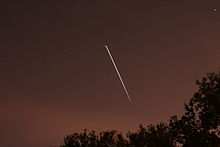Satellite pass

An orbital pass (or simply pass) is the period in which a spacecraft is above the local horizon, and thus available for line-of-sight communication with a given ground station, receiver, or relay satellite, or for visual sighting. The beginning of a pass is termed acquisition of signal (AOS); the end of a pass is termed loss of signal (LOS).[1] The point at which a spacecraft comes closest to a ground observer is the time of closest approach (TCA).[1]
Timing and duration
The timing and duration of passes depends on the characteristics of the orbit a satellite occupies, as well as the ground topography and any occulting objects on the ground (such as buildings), or in space (for planetary probes, or for spacecraft using relay satellites).[2] The longest duration ground pass will be experienced by an observer directly on the ground track of the satellite.[3] Path loss is greatest toward the start and end of a ground pass,[4] as is Doppler shifting for Earth-orbiting satellites.[5]
Satellites in geosynchronous orbit may be continuously visible from a single ground station, whereas satellites in low Earth orbit only offer short-duration ground passes[3] (although longer contacts may be made via relay satellite networks such as TDRSS). Satellite constellations, such as those of satellite navigation systems, may be designed so that a minimum subset of the constellation is always visible from any point on the Earth, thereby providing continuous coverage.[2]
Prediction and visibility
A number of web-based and mobile applications produce predictions of passes for known satellites.[6] In order to be observed with the naked eye, a spacecraft must reflect sunlight towards the observer; thus, naked-eye observations are generally restricted to twilight hours, during which the spacecraft is in sunlight but the observer is not. A satellite flare occurs when sunlight is reflected by flat surfaces on the spacecraft. The International Space Station, the largest artificial satellite of Earth, has a maximum apparent magnitude of –5.9,[7] brighter than the planet Venus.[8]
See also
- Ground track, the path on the surface of the Earth directly below a satellite
- Satellite revisit period, the time elapsed between observations of the same point on Earth by a satellite
- Satellite watching, as a hobby
References
- ^ a b "AOS, TCA, and LOS". Northern Lights Software Associates. Retrieved 17 November 2015.
- ^ a b Wood, Lloyd (July 2006). Introduction to satellite constellations: Orbital types, uses and related facts (PDF). ISU Summer Session. Retrieved 17 November 2015.
- ^ a b Del Re, Encrico; Pierucci, Laura, eds. (6 December 2012). Satellite Personal Communications for Future-generation Systems. Springer. p. 19. ISBN 978-1447101314. Retrieved 17 November 2015.
- ^ Richharia, Madhavendra (2014). Mobile Satellite Communications: Principles and Trends (Second ed.). Wiley. pp. 106–107. ISBN 978-1118810064. Retrieved 17 November 2015.
- ^ Montenbruck, Oliver; Eberhard, Gill (2012). Satellite Orbits: Models, Methods, and Applications. Springer. p. 229. ISBN 978-3642583513. Retrieved 17 November 2015.
- ^ Dickinson, David (July 11, 2013). "How to Spot and Track Satellites". Universe Today. Retrieved 17 November 2015.
- ^ "ISS Information - Heavens-above.com". Heavens-above. Retrieved 2007-12-22.
- ^ "HORIZONS Web Interface". Solar System Dynamics. Jet Propulsion Laboratory. Retrieved 13 July 2016.